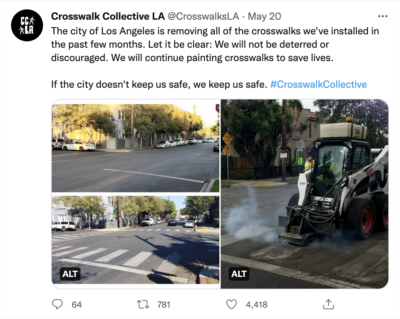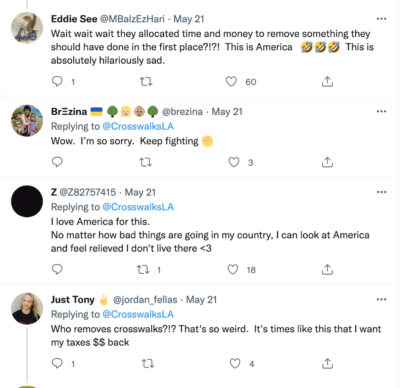Anyone Can Do This
June 2, 2022
Text by Becca Kauffman with Crosswalk Collective LA
“The bureaucracy has failed to provide the bare minimum for our communities.”
CROSSWALK COLLECTIVE LA
In Spring 2022, an anonymous group of Los Angeles do-gooders made national headlines for painting unsanctioned crosswalks at dangerous intersections in underserved parts of the city: “Vigilantes paint own crosswalks in Los Angeles CA;” “Mystery crosswalks pop up in busy East Hollywood intersection;” “A secretive LA group has a new mission: paint untouched crosswalks.” Why were they painting these crosswalks? Because the Los Angeles Department of Transportation wasn’t. Crosswalk Collective LA (CCLA) emerged in the Twitterscape with before and after shots of their renegade handiwork, bluntly declaring, “Until City Council acts, we paint crosswalks.”
What was it about painting a few stripes on the pavement that struck the media as so sensational, or even newsworthy at all? Maybe it’s because there are agencies, bureaus, and departments who we are told “take care of that”; who authorize the upkeep and improvements of the place we live so we’re safe to move freely. It’s easy to think of our city infrastructure as something built-in, untouchable, and handled by the pros, but what if they’re…not handling it? Did you know you could just take a bucket of traffic paint, consult the Manual for Uniform Traffic Control Devices for exact measurements, borrow a few traffic cones, and do it yourself? Why wait months or years for the change you seek, when all that stands between you and the crosswalk of your dreams is a trip to the hardware store and a couple helpful hands?
If you take a look at any Twitter or Reddit threads about the Department of Transportation (DOT) in any major city, the prevailing attitude is readily apparent: frustration over inaction and bureaucracy, bureaucracy, bureaucracy. The Los Angeles Department of Transportation, for example, is backed up with hundreds of requests for crosswalks from city residents. As the statistics for nationwide traffic violence and pedestrian deaths surge to epidemic proportions, it’s not surprising that a few fed up citizens felt called to take matters into their own hands.
I, too, was taken with Crosswalk Collective LA’s puncturing of the bureaucratic veil. I had just co-organized a rally for a crosswalk at a dangerous intersection in my own neighborhood of Ridgewood, Queens, but our method was to dialogue directly with the bureaucracy—not sidestep it entirely. While we clocked hours amassing petition signatures, attending community board meetings, and writing letters to the NYC DOT to get one crosswalk painted by the city, CCLA had painted six themselves. Their heroic outlaw approach was getting the job done.
I reached out to CCLA on Twitter as a fan, ally, and potential co-conspirator. They sent me the draft of their How To Paint a Crosswalk guide for feedback, and we arranged an off-the-record video meeting to talk about all things crosswalk—which was a satisfying thrill. To protect their anonymity, they only consented to an on-the-record interview via email correspondence.
Overcome with admiration, I admit I succumbed to a romantic outlook on the Collective’s work, but as you’ll read, Crosswalk Collective LA is not here to win anybody’s heart. They’re just here to paint crosswalks.
The following correspondence is dated May 6, 2022.
Becca Kauffman: Did you have previous experience with tactical urbanism before forming CCLA?
Crosswalk Collective LA: We didn’t. And we aren’t particularly handy, which just goes to show that anyone can do this if they do sufficient planning and research. The guide we released on our website recently, “How to Paint a Crosswalk,” is what we wished we had found when we were in the research phase. We hope it helps other groups get started.
Becca: Was there a particular incident or experience that led you to paint your first crosswalk at Romaine Street and Serrano Avenue?
CCLA: No. Just the totality of our experiences as pedestrians and cyclists in Los Angeles. It’s a beautiful city with perfect weather and should be a pedestrian paradise, but crossing the street here is a harrowing experience. The sidewalks are terrible and many of them don’t have curb cuts, so it’s a very hostile experience, especially for people with any kind of mobility issue.
Becca: How many crosswalks have you painted to date? How many are on your to-do list? And how often do you paint one? Is this your new Sunday routine?
CCLA: We have painted six. It would have been seven, but a crew from the local department of transportation happened to be driving by and called the cops on us. We have hundreds on our to-do list. We’ll just keep going until the job is done or the mayor and City Council decide to fund LADOT so they can do it.
Becca: In response to your first crosswalk on Romaine and Serrano, an LADOT spokesperson said in an official statement that any “unauthorized alteration to a street is subject to removal.” At the time of this interview, it’s been one month since you laid down those glorious white stripes. Are your crosswalks still intact? Do you expect the city to remove them, or do you suspect they’re secretly relieved someone has done their job for them?
CCLA: At this time, all crosswalks we have painted remain in place.
[Update: Three weeks after this interview, the LADOT began removing all the crosswalks CCLA painted.]

Becca: Why is street safety so important to you?
CCLA: Any injuries or deaths that result from the basic tasks of crossing the street and moving about your city to live your life are not only tragic, but very preventable.
Becca: Do you have a plan in place for what you’ll do if the LADOT actually removes your crosswalks instead of simply adding a layer of city-approved paint on top of your already perfect and professional grade handiwork?
CCLA: No, but given the public’s response to our crosswalks, we can only imagine the uproar if they’re removed.

Becca: Do you have any more actions up your sleeve? Will you be sending the LADOT an invoice for services rendered? A bill for labor and materials?
CCLA: We’re just interested in painting crosswalks. And we hope others join us!
Becca: Why do you think your renegade street projects have captured the attention of every news outlet across the nation?
CCLA: The bureaucracy has failed to provide the bare minimum for our communities. When pedestrians try to keep themselves safe, it stands out against the years of inaction by those supposedly entrusted with our safety.
Becca: In addition to being a citizen action, is this an art project?
CCLA: It is not. The reason we use a stencil and did so much research is to replicate existing crosswalks as closely as possible. Our only goal is to provide painted crosswalks for increased pedestrian safety.
Becca: Your anonymity is totally iconic. Everybody loves a do-gooder vigilante. It brings to mind artist action groups like Guerrilla Girls and Yes Men. Aside from the obvious legal protection that a secret identity provides, is there additional strategic thinking around this move?
CCLA: Not at all. We just want to be left alone to paint crosswalks.
Becca: Do your friends and family know about your membership in this secret club?
CCLA: Some do. We’re not that good at keeping secrets.
Becca: Have you had any close calls with the authorities? Is that something you’ve prepared for as a group, and if so, what is the protocol?
CCLA: Yes, we have prepared for all eventualities, whether it’s arrest or fines. LADOT did call the police on us and each CCLA member out that day got hit with a $250 fine for “injury to public property.” We were told by the police that the next round of fines would be $500 per person, then $1000 per person. We are fundraising on GoFundMe to pay for the fines.
Becca: Do you, like me, have a newfound fetish for crosswalks everywhere?
CCLA: Absolutely. We find ourselves scrutinizing them as we pass by. We think ours hold up well in comparison to official ones!
Becca: What’s your ideal outcome for this project?
CCLA: An LA where every street is safe to cross.
Crosswalk Collective LA is an anonymous group of Los Angeles residents who paint unsanctioned, professional-grade crosswalks at dangerous intersections in their city. Their motto is, “If the city doesn’t keep us safe, we keep us safe.” Follow their step-by-step how-to guide to paint a crosswalk in your area. Find them on twitter at @CrosswalksLA.
Becca Kauffman (they/them) is a social artist based in Queens, New York exploring art as a public utility through interactive performance, devised gatherings, and neighborhood interventions. A lover of strangers, they rely on chance encounters and citizen journalism to understand and contribute to the social choreography of shared public space, such as the crosswalk. Their work has taken the form of a residency on the streets of Times Square, a neighborhood rally and performance intervention for a crosswalk, T-shirts that function as conversation pieces, and a hi-visibility pedestrian parade with a group of fifth graders. A trained performer and working voice over actor, Becca is currently an MFA candidate in Art and Social Practice at Portland State University, where they are researching live action role play, tactical urbanism, and the curious phenomenon of the dancing crossing guard. You can follow their art practice @signalsfortraffic and their music/performance work @jennifervanilla.


